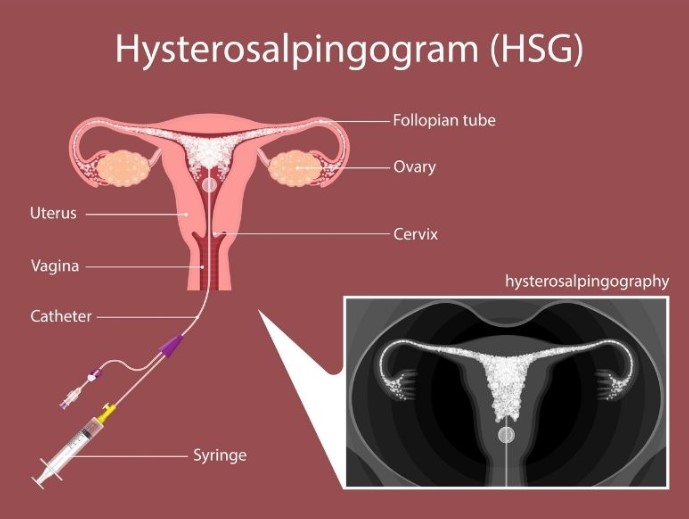A hysterosalpingography, or uterosalpingography, uses X-rays to create an image of the uterus and fallopian tubes in a person with female anatomy. It tests for causes of pregnancy problems or infertility.
A hysterosalpingography is a type of X-ray that looks at a woman’s uterus (womb) and fallopian tubes (structures that transport eggs from the ovaries to the uterus). This type of X-ray uses a contrast material so that the uterus and fallopian tubes show up clearly on the X-ray images. The type of X-ray used is called a fluoroscopy, which creates a video image rather than a still picture.
The radiologist can watch the dye as it moves through your reproductive system. They will then be able to see if you have a blockage in your fallopian tubes or other structural abnormalities in your uterus. Hysterosalpingography may be also referred to as uterosalpingography.
The test will be scheduled a few days to a week after your menstrual period. This is done to ensure that you’re not pregnant. It also helps lower your risk of infection. It’s important to let your doctor know if you might be pregnant because this test can be hazardous to the fetus. Also, you should not have this test if you have pelvic inflammatory disease (PID) or unexplained vaginal bleeding.
This X-ray test uses contrast dye. Contrast dye is a substance that, when swallowed or injected, helps to highlight specific organs or tissues from those around them. It does not dye the organs and will either dissolve or leave the body through urination. Tell your doctor if you’ve been allergic to barium or contrast dye.
Metal can interfere with the X-ray machine. Before the procedure, you’ll be asked to remove any metal from your body, such as jewelry. An area will be provided to store your belongings, but you may wish to leave your jewelry at home.
This test requires that you put on a hospital gown and lie on your back with your knees bent and your feet spread, as you would during a pelvic examination. The radiologist will then insert a speculum into your vagina. This is done so that the cervix, which is located at the back of the vagina, can be seen. You may feel some discomfort.
The radiologist will then clean the cervix and inject a local anesthetic into the cervix to reduce discomfort. The injection may feel like a pinch. Next, an instrument called a cannula will be inserted into the cervix, and the speculum will be removed. The radiologist will insert dye through the cannula, which will flow into your uterus and fallopian tubes.
You’ll then be placed under the X-ray machine, and the radiologist will begin taking X-rays. You may be asked to change positions several times so that the radiologist can capture different angles. You may feel some pain and cramping as the dye moves through your fallopian tubes. When the X-rays have been taken, the radiologist will remove the cannula. You’ll then be prescribed any appropriate medications for pain or infection prevention, and you’ll be discharged.
Complications from hysterosalpingography are rare. Possible risks include:
- allergic reaction to contrast dye
- endometrial (uterine lining) or fallopian tube infection
- injury to the uterus, such as perforation
After the test, you may continue to have cramps similar to those experienced during a menstrual cycle. You may also experience vaginal discharge or slight vaginal bleeding. It would be best to use a pad instead of a tampon to avoid infection during this time.
Some women also experience dizziness and nausea after the test. These side effects are expected and will eventually go away. However, let your doctor know if you experience symptoms of infection, including:
- fever
- severe pain and cramping
- foul-smelling vaginal discharge
- fainting
- heavy vaginal bleeding
- vomiting
After the test, the radiologist will send the results to your doctor. Your doctor will go over the results with you. Your doctor may want to do follow-up examinations or order further tests depending on the results.
